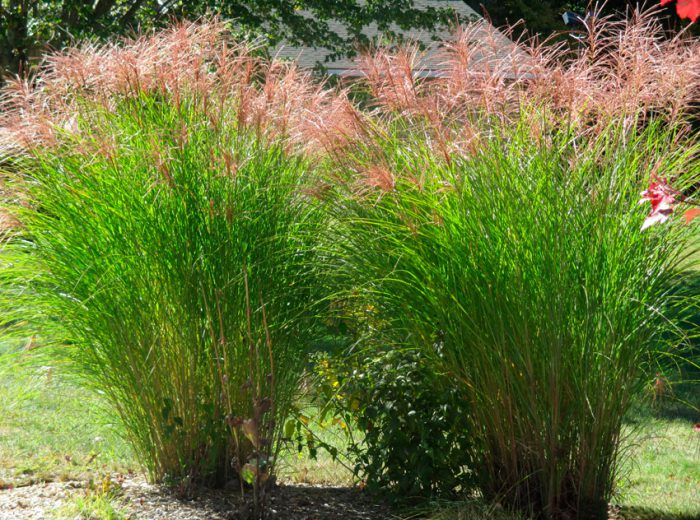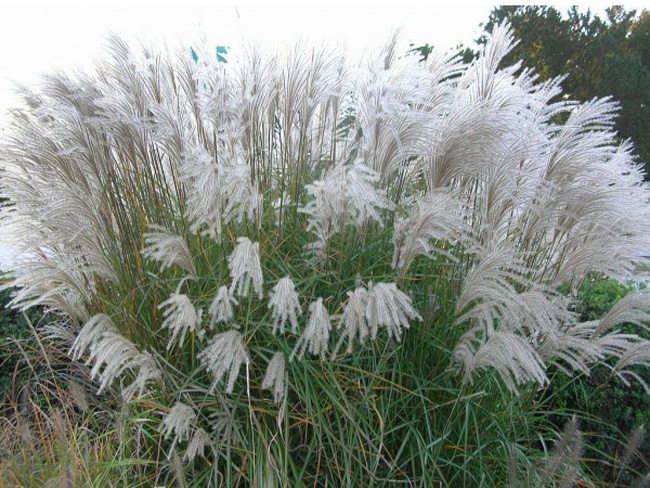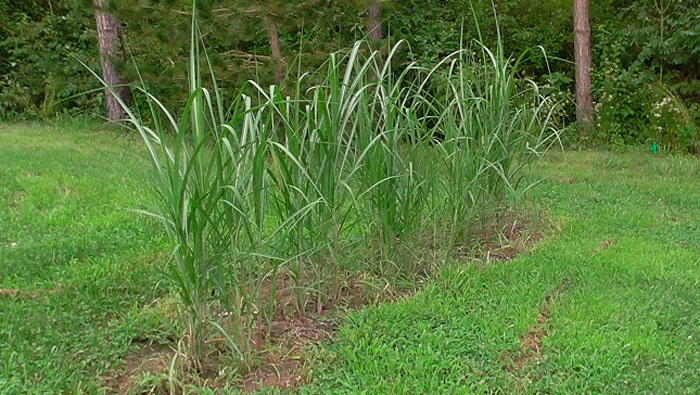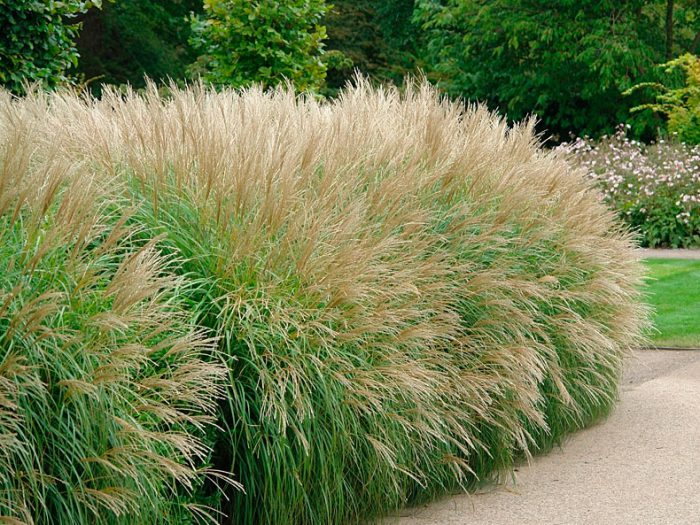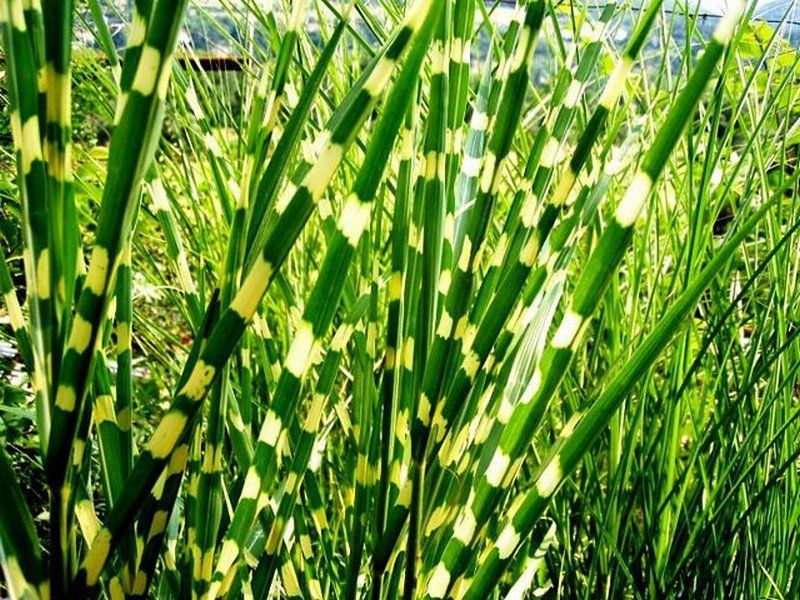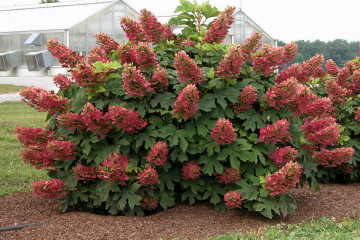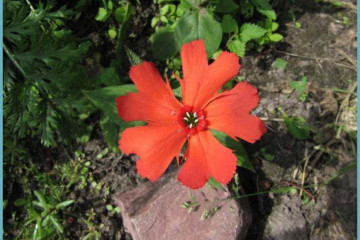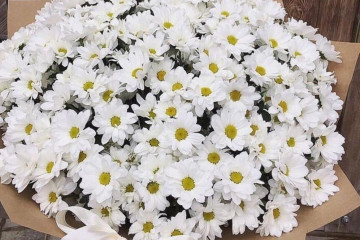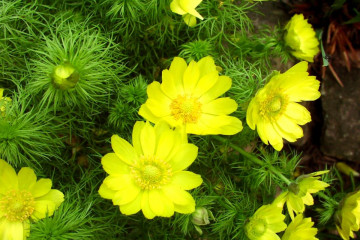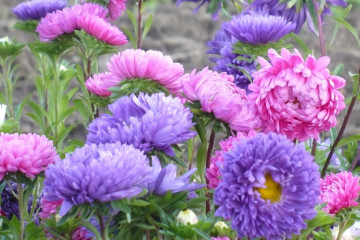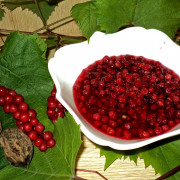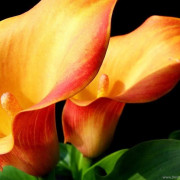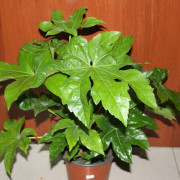Miscanthus - planting and care in the open field
Content:
Miscanthus Chinese or Miscanthus sinensis is an ornamental plant that looks like an ordinary reed or grass. Homeland - China, Korea, South Kuriles.
In the wild, the plant grows in lowlands in well-lit areas. The bush reacts positively to high humidity in the air and soil.
Miscanthus characteristics: varieties and varieties
There are many species and varieties of Miscanthus, which are characterized by different requirements for care and external growing conditions.
Sugar-flowered Miscanthus or Sugar-flowered Miscanthus most often grows in areas with high humidity. The height of the cereal reaches 2 meters. The leaf plates are thin, pale green in color. Panicles are silvery with a pink tint.
It is a thermophilic flower with the most intense growing season. The flowering period, under favorable conditions, begins in July and lasts until the onset of frost. The variety tolerates severe cold well, does not require the construction of special shelters. Before the temperature drops, it is advisable to mulch the soil around with hay or finely mown grass.
Miscanthus giant - a variety bred by breeders, is a complex hybrid plant. Tall erect shoots reach 3 meters, drooping leaves are narrow - only 25 mm wide.
The leaf plate is dark green, with a central white stripe. Outwardly, culture resembles a fountain. During the flowering period, the plant develops pale pink panicles, which turn silver by the end of the process.
It is best to plant this species in the back of the yard, as in late summer the lower leaves dry out and look unpresentable.
One of the most decorative varieties is Miscanthus Chinese Gracilimus. The oldest representative of the species. External signs of a plant:
- round bush shape;
- flowers are bright red;
- drooping foliage of golden color.
Miscanthus Gracilimus begins to bloom very late - in autumn, therefore, in regions with prolonged cold weather and short summer, this species does not bloom. The total height of the bush is more than 2 meters. The size of the cereal directly depends on the habitat. The plant reaches its maximum growth in the shade and at high humidity.
Miscanthus Moning Light is a powerful round bush. The variety can be planted even in wetlands to decorate the reservoir. The green leaf plates of the plant have a white border on both sides at the edges.
Due to the long period of preservation of decorativeness, the variety has been a favorite of all gardeners and designers for many years. In autumn, Moning Light can be painted in the most unusual colors: yellow, brown, burgundy. Even in winter, this allows the bush to remain a decoration of the garden.
Miscanthus Flamingo is a very beautiful representative of this species. Plant height can reach 2 meters. The inflorescences are larger than those of other varieties and are colored with a rich pink color. The leaf plate is long and narrow, green in color.
The leaves of Miscanthus Striktus have white, dense stripes. The height of the culture in adulthood is 3 meters.Flowers have a red tint.
Miscanthus Purpurescens is the most compact of the varieties. The height of the bush reaches only 1.5 meters. In autumn, the leaves turn dark orange with a red tint. If the bush is planted in a dry place, then the growth process will be much slower than in wetlands. The variety does not tolerate sandy and clay soils.
Miscanthus Little Zebra. The name is due to the appearance of the cereal. On each sheet, it has transverse beige stripes. The height of the plant varies depending on the habitat - from 2.5 to 3 meters.
Miscanthus Goliath in adulthood reaches 2.7 meters. Leaves are usually green. Flowers are formed late, in late summer - early autumn, and have a double coloration. The inflorescences are mostly white, the tops are pink.
Planting a plant
For plants of the Miscanthus species, planting and care in the open field involves a number of mandatory measures. Choosing the right place is an extremely important aspect, because in joint plantings, the plant behaves very aggressively and other flowers can survive.
Planting and caring for Miscanthus are carried out in fenced areas. The fences are dug in 20 cm deep and the aboveground level should be at least 10 cm. This height of the fence is due to the ability of the root system to "jump" over small elevations.
Seed planting
Pre-processing of the planting material is not required. The seeds are planted in individual containers, preferably in peat tablets. In spring, seedlings can be transplanted into open ground. The bush reaches its peak growth only in the 3-4th year.
Planting seedlings
Due to the short growing season, experts recommend purchasing only adult planting material. The lot of a young plant does not have time to develop and grow strong enough after transplanting or planting.
Watering and loosening the soil
The plant needs high humidity. It needs to be watered abundantly with a hose. At elevated temperatures, in order to avoid the death of the seedling, the volume of water procedures increases.
At a young age, in the first two years, the ground near the bush is carefully weeded. Since the crop grows very quickly, no further weeding is required. There is no need to loosen the soil around it.
Reproduction methods
The transplant is carried out only at the moment the old stems begin to die off in the middle of the bush. Due to the fact that the culture does not tolerate this procedure well, it is better to combine it with the reproduction of the plant by the method of division.
It is important to approach the transplant as responsibly as possible. After this procedure, the grain is restored for a long time and painfully. Dividing the bush can be done in autumn or spring.
The longest way to propagate a shrub is by seed.
Top dressing and fertilizers
For proper development and growth, it is important to feed the cereal plant in a timely manner. In the first year, young cereals cannot be fertilized. In the second half of May, a urea solution is introduced under the bush, prepared according to the instructions. At the beginning of summer, treatment with humates is carried out, for example, Gumin. At the end of the summer season, the soil is fertilized with phosphorus-potassium preparations.
Plant transplant
The description of the process of transplanting a bush fully corresponds to the method of reproduction by division. A part of the bush is planted in a pre-prepared fenced place, the soil must be carefully watered. After transplanting, the plant needs timely feeding and maintaining the necessary air humidity.
Pruning Miscanthus
You do not need to cut the plant in the fall. Stems and leaves are not recommended to be cut, as they serve as a natural defense of the cereal during the cold season.In the spring, only dead leaf plates are cut off, since the plant is late and grows very poorly.
Pests and diseases
The cereal is resistant to all known diseases and practically does not react to the invasion of pests. The only thing that can destroy him is drought. During such periods, the plant instantly dies.
Flowering period and care during this period
Flowering in most species begins in June and can last the entire summer period. Spikelets reach a length of 1 cm and are located inside loose panicles. Inflorescences change color as they ripen.
During the flowering period, you need to take care of the plant more carefully: it requires abundant moisture in the soil and air. Watering should be done in the early morning or late evening. For a more intense flower formation, the cereal is fed with complex fertilizers.
Preparing for winter
The perennial bush is characterized by increased winter hardiness. To preserve the culture, it must be covered with special agromaterials, for example, sphagnum moss. To protect Miscanthus from wind load, a wooden frame should be built around it. Before forming a shelter, the bush is covered with a thick layer of mulch on all sides.
Use in landscape design
Miscanthus is often used by Chinese designers to decorate the coastline of water bodies. The plant also looks good as a framing for lawns. Florists use inflorescences and panicles to create flower arrangements. Perennials of this type are recommended to be used both in group and in single plantings.
Due to the preservation of external decorativeness throughout the season, Miscanthus Chinese won the love of not only amateur gardeners, but also professional designers. The plant is absolutely unpretentious to care for. It is for this reason that he will find a place in any garden, even in the most exquisite.
